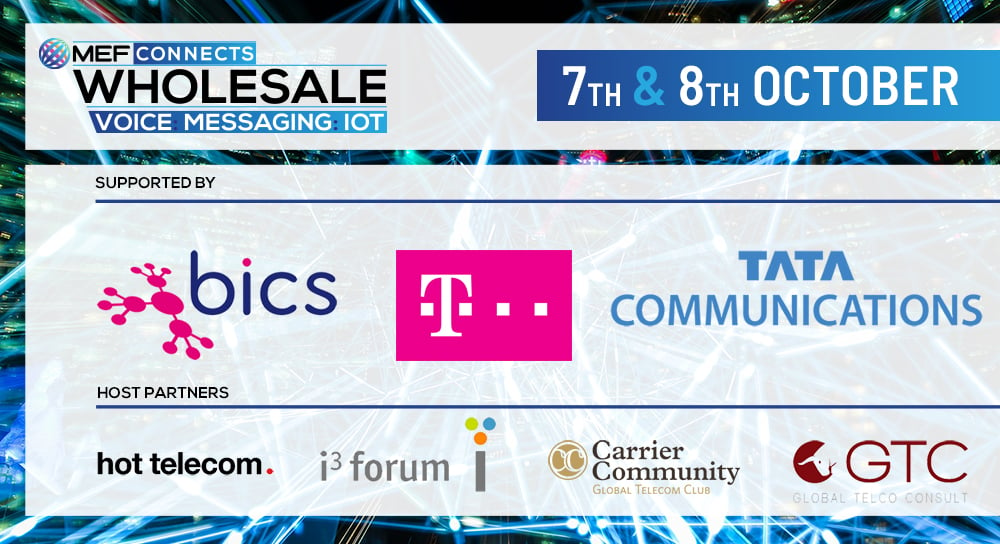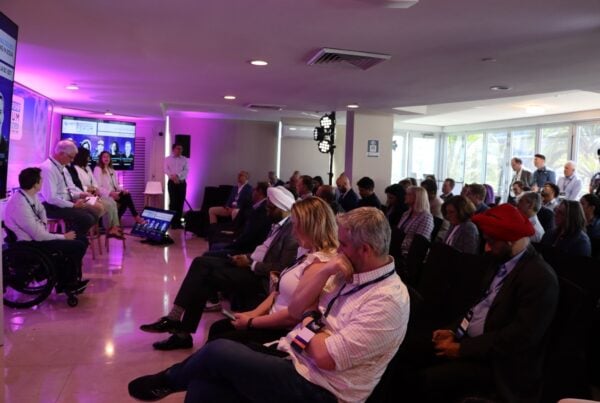During MEF Connects Wholesale, MEF IoT advisor Andrew Parkin-White was joined by a panel of experts to explore market development in IoT connectivity comprising:
- Fernando Llobregat Baena, Head of IoT Sales for Enterprise, BICS
- Martin Garner, COO, CCS Insight
- Olaf Giehl, Senior Project Manager, Telekom Carrier Services
- Craig Price, SVP, Mobility Products and Marketing, PCCW Global
- David Hambling, CEO Asia Pacific, Pod Group
- Stuart Mitchell, Chief Evangelist and Head of Product, Zariot
The panel session explored a range of topics including a discussions of which segments, geographies and technologies offer the greatest opportunities, how are communications service providers (CSPs) addressing these opportunities and what kind of retail strategies and competitive environment is developing?
Watch the full panel discussion in the event video
The IoT connectivity market is large and growing
Estimates are that IoT connections over cellular will grow from 1.2bn in 2019 to 4.7bn by 2020 (Transforma Insights) with connectivity accounting for around 10% of the overall market value – very clearly an important and valuable market.
The panel concurs that IoT is an attractive market. Despite the impact of Covid, Stuart of Zariot is seeing substantial activity and new use cases are emerging. Fernando of BICS is encountering growth and starting to get more and more interest from companies wanting international connectivity or to deploy new services.
Healthcare is growing hugely in this region at present, largely due to the pandemic. Manufacturing remains a key area as industries begin to digitalise and increase their resilience. Logistics and supply chain remain important markets.“
Some regions are leading this growth and key segments are forging ahead
The IoT connectivity market is focused on a number of geographical areas with the USA, Developed Asia and Europe representing higher growth markets. Craig of PCCW Global notes that In Asia, the Chinese market has increasing importance and European suppliers are looking to Asia as a rapidly developing market. David from Pod Group supports this view, commenting on significant growth in Asia with the emergence of new applications. Healthcare is growing hugely in this region at present, largely due to the pandemic. Manufacturing remains a key area as industries begin to digitalise and increase their resilience. Logistics and supply chain remain important markets.
David from Pod Group also points out that there are interesting emerging markets in South America and Africa. Stuart from Zariot says that there is much interest in traditional IoT in Africa with automotive applications and vehicle tracking becoming important.
Barriers to entry are falling driving wider IoT adoption
The overall IoT market is gaining momentum with growth in many segments and Martin from CCS Insight emphasises this point with an accelerating trend from industries for digitalisation particularly driven by Covid. Stuart from Zariot points out that prospective customers need to see the opportunities of IoT and not just the challenges. Fernando from BICS lends a supportive voice, recognising that the barriers to entry for IoT are lowering and enterprises and enterprises are embracing solutions. He concludes that more enterprises will adopt as the barriers to entry fall and the adoption cycle becomes shorter. Craig from PCCW Global believes that enterprises are beginning to understand the benefits of cellular coverage and are conducting trials around this. CSPs can partner with enterprises to develop IoT use cases, demonstrate the commercial benefits and business case and to help to develop an IoT service.
To bring value beyond connectivity, adding security and cloud connectivity provide a further service wraparound.“
CSPs should move beyond simple IoT connectivity
Martin from CCS Insight points out the IoT is not just about connectivity and that it should be part of an overall solution. CSPs should look to the other 90% of the IoT value chain that is not connectivity. Craig from PCCW Global considers that the price of connectivity is in decline and is only small part of the IoT ecosystem. To bring value beyond connectivity, adding security and cloud connectivity provide a further service wraparound.
Fernando from BICS supports this view and believes that CSPs should approach the market as a solutions provider, rather than simply focusing on connectivity, to gain maximum revenue. Olaf from Deutsche Telekom stresses the importance of standardised tools to develop the market allowing easier management and integration of data. Stuart from Zariot is of the opinion that all customers want a solution and not just connectivity and that partnerships are the way forward to develop the IoT market. A value added partnership approach to IoT will drive market growth.
The competitive environment is evolving and CSPs need to adapt to secure their future
Martin from CCS Insight sees a powerful trend emerging from industrial IoT where cellular is not used as widely. We are now seeing the emergence of IoT app stores that can manage the complex task of managing all the software. He points to the emergence of a complex relationship emerging between hyperscale players and CSPs. A CSP needs to determine where it fits in. At present, hyperscalers lack reach and CSPs can provide this. They need to be solutions providers and architects and it is important to build trust between both sides and collaborate and CSPs need to find a role to play in this new status quo.
David from Pod Group points to the role played by the MVNO is growing the IoT market. He considers that MVNOs have evolved from being resellers of basic connectivity to competing with mobile network operators (MNOs). They can offer value added platforms to enhance a pure connectivity offering and give control to the customer.
It will clearly be a time of great change in the IoT value chain. The competitive dynamics will transform and CSPs will need to determine their role in the evolution of IoT connectivity. As Martin from CCS Insight concluded by saying – there is a strong need for solutions architects, especially if the value of connectivity is reduced. It is important to focus on the 90% of the IoT market that is not connectivity and extract value there
MEF Connects Wholesale On Demand
MEF Connects Wholesale takes an ecosystem perspective to explore the business trends and challenges driving connectivity today and asks what will create tomorrow’s business?
Across 2-days, we took a detailed look at wholesale trends across Voice, IoT, Messaging & RCS. MEF Members can visit the Member only On Demand page to get presentation slides as well.
Watch now






